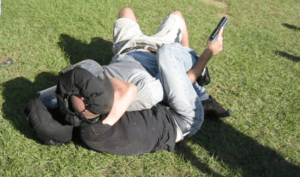Once again I stumbled across a firearms instructor online who is talking about integrating grappling into a firearms context. While I am all for others recognizing and publicly talking about the absolute need to have some functional ability in this area, unfortunately it all too often gives me a bad case of heartburn when I see it.
To be clear, the more dialogue and discussion about this the better because I don’t know that we have all the answers yet, and I always hold out the expectation that the stuff I do can be improved upon. But to engage in that kind of discussion, both parties need some depth and breadth of experience to truly understand it and to attempt to figure out best practices.
What tends to happen though is that weapon integrated grappling is so relatively new, and such a complex skill set, that few people have the ability to truly comprehend the variables and fine points, and even fewer have taken time to actually work it under authentic conditions (rolling around a few times with friends who know as little as you about this DOES NOT COUNT towards understanding – period ) and so a good number of those who discuss it have no clue what they are saying.
For example, those who don’t know much will almost always trot out the “sport grappling” label pretty quickly. Why is that wrong? Because they can’t tell you what it means! First of all, they have never done any “sport grappling” so how can they possibly know what it entails? The answer is that they don’t. You know how to prove that? The next time you see that mentioned online somewhere, ask them what is the difference between “combative” grappling and “sport” grappling outside of specific context. Be prepared for a bunch of nonsense and straw man crap, because they have no clue at all. They cannot answer the question factually, and they certainly cannot answer it succinctly. You can’t talk clearly about what you do not know.
Entangled fighting, especially on the ground is the single most complex aspect of combat, and this complexity is exacerbated by virtue of the fact that it is also has the most variables, and those variables can be measured sometimes in tiny increments, and can change completely in the blink of an eye. Here is the quickest illustration I know of – if two people are engaged in a gunfight at 10 yards, having one of the parties move their elbow two inches will most likely will not have the slightest impact of the results of the shootout. On the ground and entangled, moving your elbow two inches is quite literally and with zero hyperbole the difference between life and death. If someone is trying to teach grappling and they cannot understand that, then they have no business even throwing in an opinion in any way.
Why does it bug me so much? Mostly because of the implied narcissism inherent in someone who knows little pretending to know much, and who puts out false information that may very well get a good person injured or killed. It is also a screaming insult to those who have put in the time to study it, and having someone whose resume consists of getting certified after taking a five day grappling course, playing around with a few others on occasion who know just as little, and teaching a couple of moves to people who have never done any grappling try to pontificate about things like best practices or training methods is nauseating.
If I turned it around, and had the same exact resume, but instead of grappling, made it shooting, how many of these top instructors would take me seriously? How many would graciously engage in a sociable discussion? We all know the answer – ZERO. Not only would they not take me seriously, they would rage publicly and privately to all who would listen about these “new tactical gun instructors who know nothing but want to be on the same level as us! How dare they?” All I ask is that they look in the mirror first before speaking on things they really should remain quiet about.

